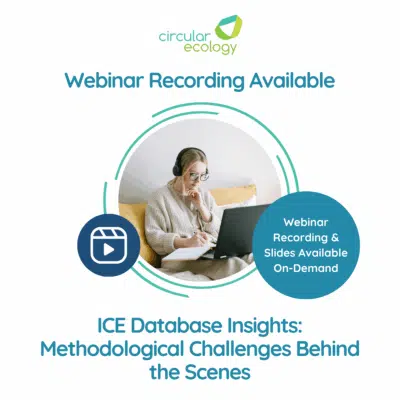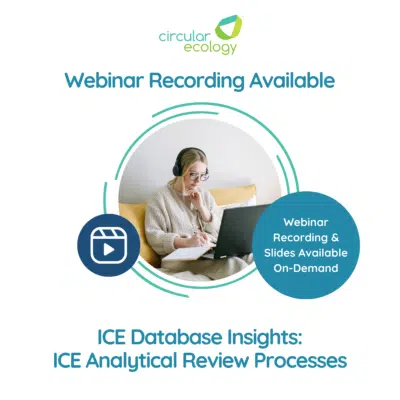Environmental Glossary of Terms and Definitions
Definitions of some common terms used in carbon footprinting, resource efficiency and life cycle assessments:
Allocation
Allocation is a term used in carbon footprinting and LCA. Allocation is a procedure that is used to divide (“allocate”) a single input (i.e. energy) between two different outputs. For example in the case of a combined heat and power (CHP) system it may consume a single fuel, such as natural gas. However the CHP system produces both heat and electricity. The GHG emissions from the combustion of the gas needs to be divided between the generation of heat and electricity. The common ways of doing this are by energy content (i.e. MJ, kWh produced …etc), economic value (i.e. the total economic value of heat versus total value of electricity generated) or in this case of CHP to consider the relative quality of the heat and electricity. Allocation methods can be influential to results and therefore it’s important to pick a fair allocation method.
Boundary conditions
Boundary conditions are used to define what is included in a study. The common boundary conditions are cradle to gate, cradle to site and cradle to grave. However full boundaries should also define what was excluded (i.e. due to a lack of data, or inputs that were assumed negligible).
Carbon footprint
A carbon footprint is a measure of the amount of greenhouse gas (GHG) emissions that are released within the boundaries of study. A carbon footprint is often measured in the units of kg or tonnes of CO2e. A true carbon footprint starts at the cradle and measures the release of GHG emissions throughout a supply chain or lifecycle.
Carbon sequestration
Carbon sequestration is normally discussed when assessing naturally grown materials, such as timber. When a tree grows it absorbs carbon dioxide (CO2) from the atmosphere (through photosynthesis) and stores the carbon (C) within the make up of the tree. Wood is roughly 50% carbon by dry weight. This could be claimed as biogenic carbon storage in an embodied carbon assessment, which is in essence a carbon benefit to the results. However, it is important to appreciate that at the end of life of such materials the stored carbon may be released back into the atmosphere, for example through incineration or through decaying in a landfill. If including carbon sequestration in a study, then it’s important to take care in modelling the results and to appreciate the end of life scenario.
The cradle
The cradle is defined as the earth. It is used as the start of the boundary for embodied carbon, carbon footprint and LCA assessments, i.e. the extraction of materials from the ground.
Cradle to cradle
‘Cradle to cradle’ goes beyond ‘cradle to grave’ and conforms more to the model of the circular economy. In a cradle to cradle model products would be designed in a way so that at the end of their initial life they can be readily reused, or recycled, and therefore avoid landfill altogether.
Cradle to gate
Cradle to gate is a boundary condition associated with embodied carbon, carbon footprint and LCA studies. A study to these boundaries considers all activities starting with the extraction of materials from the earth (the cradle), their transportation, refining, processing and fabrication activities until the material or product is ready to leave the factory gate.
Cradle to site
Cradle to site is a boundary condition associated with embodied carbon, carbon footprint and LCA studies. A study to these boundaries includes the cradle to gate results and the transportation of the material or product to its site of use.
Cradle to grave
Cradle to site is a boundary condition associated with embodied carbon, carbon footprint and LCA studies. A study to these boundaries includes the cradle to site results but also includes the GHG emissions associated with the in use of the material or product (maintenance) and the end of life (disposal, reuse, recycling).
Embodied carbon
Embodied carbon may be defined as the carbon footprint of a material. It considers the amount of greenhouse gas emissions (GHGs) that are released throughout a production supply chain to produce a material or product. It is often measured with the boundaries of cradle to gate, cradle to site, or cradle to grave. It considers all extraction, transport, processing and fabrication activities of a material or product. Embodied carbon differs from a carbon footprint in that embodied carbon can only be associated with materials or products, whereas a carbon footprint could also measure the GHG emissions in the operation of a building, for example.
Functional unit
The functional unit of assessment is a reference unit for presenting results. It allows two products, or systems, to be compared in a fair manner. For example, a functional unit could be “a 1 person chair with a lifetime of 10 years”. Setting a fair functional unit is not always as simple as it initially seems.
Life Cycle Assessment (LCA)
Life cycle assessment, also known as life cycle analysis, considers a full basket of environmental impact categories, beyond just carbon. For example, it can produce results for toxicity, eutrophication, acidification, water depletion, resource depletion…etc. LCA can be a powerful decision support tool, but requires a higher level of expertise than an embodied carbon assessment or carbon footprint.
Webinar Recap: ICE Insights: Methodological Challenges Behind the Scenes
Circular Ecology hosted the fourth webinar in the ICE Database Insights webinar mini series on [...]
Jun
DESNZ (Defra) 2025 GHG Emissions Factors Released
The UK Department for Energy Security and Net Zero (DESNZ) have just released the 2025 [...]
Jun
Webinar Recap: ICE Insights: Are All EPDs Created Equal?
On Thursday, 22nd May, Circular Ecology hosted the third instalment in the ICE Database Insights [...]
May
Webinar Recap: ICE Insights: ICE Analytical Review Processes
On Wednesday, April 30th, Circular Ecology hosted the second session of our ICE Database Insights [...]
Apr




